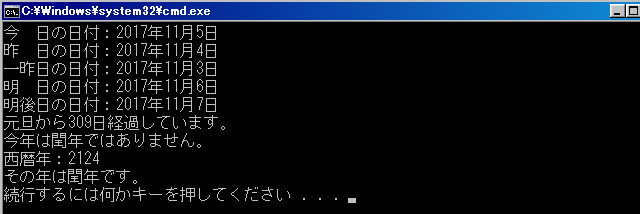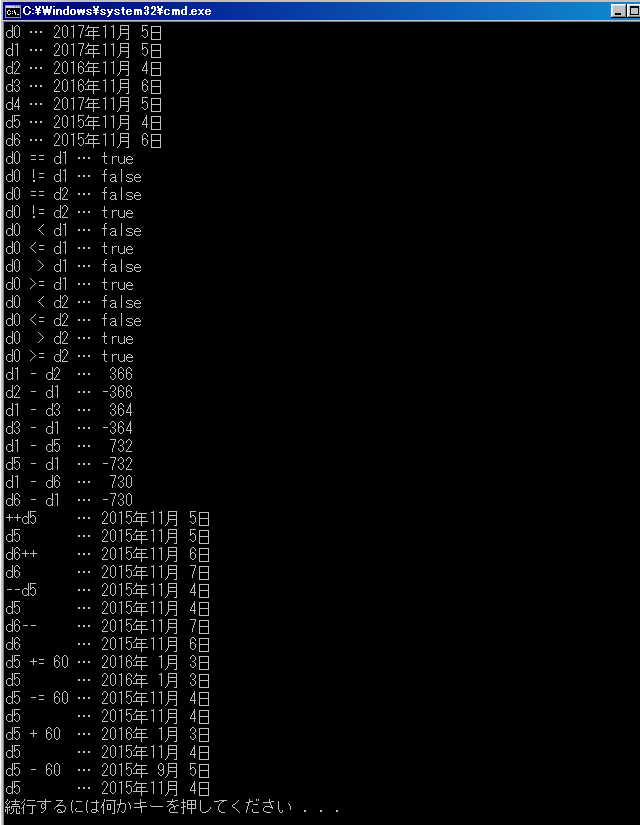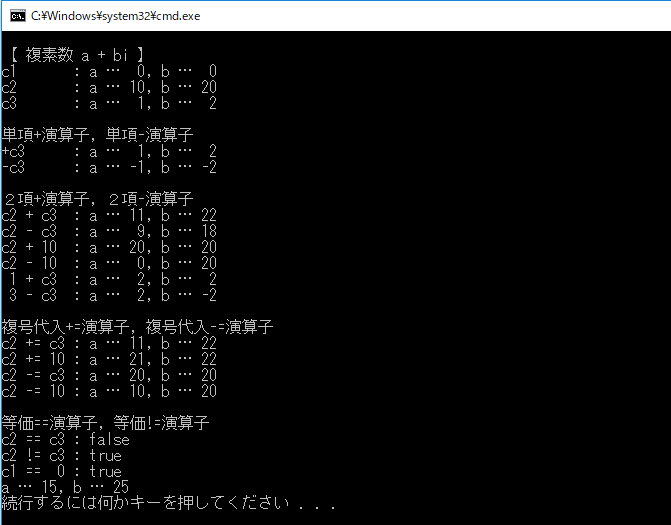�V�K�L���̓��e���s�����ƂŁA��\���ɂ��邱�Ƃ��\�ł��B
�L��
�V�K�L���̓��e���s�����ƂŁA��\���ɂ��邱�Ƃ��\�ł��B
posted by fanblog
2017�N11��05��
�s����106�t �ÓI�f�[�^�����o�C�ÓI�����o���C���Z�q���ip.473���K13-1�j
�@���̃v���O�����́A�V�Ŗ���C++����� p.469 �` p.472 �ɂ�����t�Ɋւ���v���O�����ł��B
�ÓI�f�[�^�����o�@static int dmax[];
�ÓI�����o���@ static int days_of_month(int y, int m);
static bool leap_year(int year)
�́A����̃I�u�W�F�N�g�ł͂Ȃ��N���X�S�̂Ɋւ��f�[�^�i�e���̓����j�܂��͍�Ɓi�e���̓����ׂ�A�[�N���ǂ����ׂ�j�ł��B
���̂悤�ȃf�[�^���Ƃ́A�ÓI�f�[�^�����o�E�ÓI�����o���Ŏ�������ׂ��ł��B
------------------------------------------------
// Date.h
#ifndef ___Class_Date
#define ___Class_Date
#include <string>
#include <iostream>
class Date {
int y; // ����N
int m; // ��
int d; // ��
static int dmax[]; // �e���̓���(�ÓI�ް�����)
static int days_of_month(int y, int m); // y�Nm���̓���(�ÓI���ފ�)
public:
Date(); // ��̫�ĺݽ��
Date(int yy, int mm = 1, int dd = 1); // �ݽ��
static bool leap_year(int year) { // �[�N�Ȃ� true ��ԋp(�ÓI���ފ�)
return year % 4 == 0 && year % 100 != 0 || year % 400 == 0;
}
int year() const { return y; } // �N��ԋp
int month() const { return m; } // ����ԋp
int day() const { return d; } // ����ԋp
bool leap_year() const { // �[�N�Ȃ� true ��ԋp(��ÓI���ފ�)
return leap_year(y);
}
Date preceding_day() const; // �O���̓��t��ԋp
Date following_day() const; // �����̓��t��ԋp
int day_of_year() const; // �N���̌o�ߓ�����ԋp
int day_of_week() const; // �j����ԋp
std::string to_string() const; // ������\����ԋp
};
std::ostream& operator<<(std::ostream& s, const Date& x); // �}���q�̑��d��`
#endif
// Date.cpp
#define _CRT_SECURE_NO_WARNINGS
#include <ctime>
#include <sstream>
#include <iostream>
#include "Date.h"
using namespace std;
// �e���̓���(�[�N�łȂ��N)
int Date::dmax[] = { 31, 28, 31, 30, 31, 30, 31, 31, 30, 31, 30, 31 };
// y�Nm���̓���
int Date::days_of_month(int y, int m) {
return dmax[m - 1] + (leap_year(y) && m == 2);
}
// ��̫�ĺݽ��(�����̓��t�ō쐬)
Date::Date() {
time_t current = time(NULL); // ���݂̗�����擾
struct tm* local = localtime(¤t); // �v�f�ʂ̎����ɕϊ�
y = local->tm_year + 1900; // �N�Ftm_year�͐���N-1900
m = local->tm_mon + 1; // ���Ftm_mon��0�`11
d = local->tm_mday;
}
// �ݽ��(�w�肵���N�����ō쐬)
Date::Date(int yy, int mm, int dd) {
y = yy;
m = mm;
d = dd;
}
// �N���̌o�ߓ���
int Date::day_of_year() const {
int days = d;
for (int i = 1; i < m; i++)
days += days_of_month(y, i);
return days;
}
// �O���̓��t
Date Date::preceding_day() const {
Date temp = *this;
if (temp.d > 1)
temp.d--;
else {
if (--temp.m < 1) {
temp.y--;
temp.m = 12;
}
temp.d = days_of_month(temp.y, temp.m);
}
return temp;
}
// �����̓��t
Date Date::following_day() const {
Date temp = *this;
if (temp.d < days_of_month(temp.y, temp.m))
temp.d++;
else {
if (++temp.m > 12) {
temp.y++;
temp.m = 1;
}
temp.d = 1;
}
return temp;
}
// �j��(���j�`�y�j��0�`6�ɑΉ�)
int Date::day_of_week() const {
int yy = y;
int mm = m;
if (mm == 1 || mm == 2) {
yy--;
mm += 12;
}
return (yy + yy / 4 - yy / 100 + yy / 400 + (13 * mm + 8) / 5 + d) % 7;
}
// ������\����ԋp
string Date::to_string() const {
ostringstream s;
s << y << "�N" << m << "��" << d << "��";
return s.str();
}
// �}���q�̑��d��`
ostream& operator<<(ostream& s, const Date& x) {
return s << x.to_string();
}
// DateTest.cpp
#include <iostream>
#include "Date.h"
using namespace std;
int main() {
Date today; // �����̓��t
cout << "���@���̓��t�F" << today << '\n';
cout << "���@���̓��t�F" << today.preceding_day() << '\n';
cout << "�����̓��t�F" << today.preceding_day().preceding_day() << '\n';
cout << "���@���̓��t�F" << today.following_day() << '\n';
cout << "������̓��t�F" << today.following_day().following_day() << '\n';
cout << "���U����" << today.day_of_year() << "���o�߂��Ă��܂��B\n";
cout << "���N�͉[�N"
<< (today.leap_year() ? "�ł��B" : "�ł͂���܂���B") << '\n';
int y, m, d;
cout << "����N�F"; cin >> y;
cout << "���̔N�͉[�N"
<< (Date::leap_year(y) ? "�ł��B" : "�ł͂���܂���B") << '\n';
}
------------------------------------------------

�V�Ŗ���C++����ҁ@p.473 ���K13-1
�@��L�̓��t�N���X Date.h �ɑ��āA�ȉ��̉��Z�q����lj��������t�N���X���쐬����B
�@�� ��̓��t�����������ǂ����肷�铙�����Z�q==
�@�� ��̓��t���������Ȃ����ǂ����肷�铙�����Z�q!=
�@�� ��̓��t�̑召�W�肷��W���Z�q>, >=, <, <=
�@�@�@�� ���V�������t�̂ق���傫���Ɣ��肷�邱�ƁB
�@�� ��̓��t�̌��Z���s���i��������Ă��邩�����߂�j���Z���Z�q�|
�@�@�@�� ���I�y�����h����E�I�y�����h���������Ɓi���t���𐳕��̒l�Ŏ����j�B
�@�� ���t�𗂓��̓��t�ɍX�V����O�u����ь�u�̑������Z�q�{�{
�@�� ���t��O���̓��t�ɍX�V����O�u����ь�u�̑������Z�q�|�|
�@�� ���t�� n ���i�߂����t�ɍX�V���镡��������Z�q�{��
�@�� ���t�� n ���߂������t�ɍX�V���镡��������Z�q�|��
�@�� ���t�� n ����̓��t�����߂���Z���Z�q�{
�@�� ���t�� n ���O�̓��t�����߂錸�Z���Z�q�|
// Date.h
#ifndef ___Class_Date
#define ___Class_Date
#include <string>
#include <iostream>
class Date {
int y; // ����N
int m; // ��
int d; // ��
static int dmax[]; // �e���̓���(�ÓI�ް�����)
static int days_of_month(int y, int m); // y�Nm���̓���(�ÓI���ފ�)
static int day_of_year(int y, int m, int d); // y�N1��1���`y�Nm��d���܂ł̓���(�ÓI���ފ�)
public:
Date(); // ��̫�ĺݽ��
Date(int yy, int mm = 1, int dd = 1); // �ݽ��
static bool leap_year(int year) { // �[�N�Ȃ� true ��ԋp(�ÓI���ފ�)
return year % 4 == 0 && year % 100 != 0 || year % 400 == 0;
}
int year() const { return y; } // �N��ԋp
int month() const { return m; } // ����ԋp
int day() const { return d; } // ����ԋp
bool leap_year() const { // �[�N�Ȃ� true ��ԋp(��ÓI���ފ�)
return leap_year(y);
}
Date preceding_day() const; // �O���̓��t��ԋp
Date following_day() const; // �����̓��t��ԋp
int day_of_year() const; // �N���̌o�ߓ�����ԋp
int day_of_week() const; // �j����ԋp
friend bool operator==(const Date& p, const Date& q);
friend bool operator!=(const Date& p, const Date& q);
friend bool operator <(const Date& p, const Date& q);
friend bool operator<=(const Date& p, const Date& q);
friend bool operator >(const Date& p, const Date& q);
friend bool operator>=(const Date& p, const Date& q);
friend int operator-(const Date& p, const Date& q);
Date& operator++();
Date operator++(int);
Date& operator--();
Date operator--(int);
Date& operator+=(int n);
Date& operator-=(int n);
Date operator+(int n);
Date operator-(int n);
std::string to_string() const;
};
std::ostream& operator<<(std::ostream& s, const Date& x);
#endif
// Date.cpp
#define _CRT_SECURE_NO_WARNINGS
#include <ctime>
#include <sstream>
#include <iomanip>
#include <iostream>
#include "Date.h"
using namespace std;
int Date::dmax[] = { 31, 28, 31, 30, 31, 30, 31, 31, 30, 31, 30, 31 };
int Date::days_of_month(int y, int m) {
return dmax[m - 1] + (leap_year(y) && m == 2);
}
int Date::day_of_year(int y, int m, int d) {
int days = d;
for (int i = 1; i < m; i++)
days += days_of_month(y, i);
return days;
}
Date::Date() {
time_t current = time(NULL);
struct tm* local = localtime(¤t);
y = local->tm_year + 1900;
m = local->tm_mon + 1;
d = local->tm_mday;
}
Date::Date(int yy, int mm, int dd) {
y = yy;
m = mm;
d = dd;
}
int Date::day_of_year() const {
return day_of_year(y, m, d);
}
Date Date::preceding_day() const {
Date temp = *this;
if (temp.d > 1)
temp.d--;
else {
if (--temp.m < 1) {
temp.y--;
temp.m = 12;
}
temp.d = days_of_month(temp.y, temp.m);
}
return temp;
}
Date Date::following_day() const {
Date temp = *this;
if (temp.d < days_of_month(temp.y, temp.m))
temp.d++;
else {
if (++temp.m > 12) {
temp.y++;
temp.m = 1;
}
temp.d = 1;
}
return temp;
}
int Date::day_of_week() const {
int yy = y;
int mm = m;
if (mm == 1 || mm == 2) {
yy--;
mm += 12;
}
return (yy + yy / 4 - yy / 100 + yy / 400 + (13 * mm + 8) / 5 + d) % 7;
}
bool operator== (const Date& p, const Date& q) {
return p.y == q.y && p.m == q.m && p.d == q.d;
}
bool operator!=(const Date& p, const Date& q) {
return !(p == q);
}
bool operator<(const Date& p, const Date& q) {
if (p.y == q.y)
return p.day_of_year() < q.day_of_year();
else
return p.y < q.y;
}
bool operator<=(const Date& p, const Date& q) {
return p < q || p == q;
}
bool operator>(const Date& p, const Date& q) {
return !(p <= q);
}
bool operator>=(const Date& p, const Date& q) {
return !(p < q);
}
int operator-(const Date& p, const Date& q) {
int delta_d = p.day_of_year() - q.day_of_year();
if (p.y > q.y) {
for (int i = q.y; i < p.y; i++)
delta_d += (365 + Date::leap_year(i));
}
if (p.y < q.y) {
for (int i = p.y; i < q.y; i++)
delta_d -= (365 + Date::leap_year(i));
}
return delta_d;
}
Date& Date::operator++() {
*this = following_day();
return *this;
}
Date Date::operator++(int) {
Date temp = *this;
*this = following_day();
return temp;
}
Date& Date::operator--() {
*this = preceding_day();
return *this;
}
Date Date::operator--(int) {
Date temp = *this;
*this = preceding_day();
return temp;
}
Date& Date::operator+=(int n) {
for (int i = 0; i < n; i++)
++*this;
return *this;
}
Date& Date::operator-=(int n) {
for (int i = 0; i < n; i++)
--*this;
return *this;
}
Date Date::operator+(int n) {
Date temp = *this;
for (int i = 0; i < n; i++)
++temp;
return temp;
}
Date Date::operator-(int n) {
Date temp = *this;
for (int i = 0; i < n; i++)
--temp;
return temp;
}
string Date::to_string() const {
ostringstream s;
s << y << "�N" << setw(2) << m << "��" << setw(2) << d << "��";
return s.str();
}
ostream& operator<<(ostream& s, const Date& x) {
return s << x.to_string();
}
// DateTest.cpp
#include <iomanip>
#include <iostream>
#include "Date.h"
using namespace std;
int main()
{
/*
Date today;
cout << "���@���̓��t�F" << today << '\n';
cout << "���@���̓��t�F" << today.preceding_day() << '\n';
cout << "�����̓��t�F" << today.preceding_day().preceding_day() << '\n';
cout << "���@���̓��t�F" << today.following_day() << '\n';
cout << "������̓��t�F" << today.following_day().following_day() << '\n';
cout << "���U����" << today.day_of_year() << "���o�߂��Ă��܂��B\n";
cout << "���N�͉[�N"
<< (today.leap_year() ? "�ł��B" : "�ł͂���܂���B") << '\n';
int y, m, d;
cout << "����N�F"; cin >> y;
cout << "���̔N�͉[�N"
<< (Date::leap_year(y) ? "�ł��B" : "�ł͂���܂���B") << '\n';
*/
Date d0; cout << "d0 �c " << d0 << '\n';
Date d1(2017, 11, 5); cout << "d1 �c " << d1 << '\n';
Date d2(2016, 11, 4); cout << "d2 �c " << d2 << '\n';
Date d3(2016, 11, 6); cout << "d3 �c " << d3 << '\n';
Date d4(2017, 11, 5); cout << "d4 �c " << d4 << '\n';
Date d5(2015, 11, 4); cout << "d5 �c " << d5 << '\n';
Date d6(2015, 11, 6); cout << "d6 �c " << d6 << '\n';
cout << boolalpha;
cout << "d0 == d1 �c " << (d0 == d1) << '\n';
cout << "d0 != d1 �c " << (d0 != d1) << '\n';
cout << "d0 == d2 �c " << (d0 == d2) << '\n';
cout << "d0 != d2 �c " << (d0 != d2) << '\n';
cout << "d0 < d1 �c " << (d0 < d1) << '\n';
cout << "d0 <= d1 �c " << (d0 <= d1) << '\n';
cout << "d0 > d1 �c " << (d0 > d1) << '\n';
cout << "d0 >= d1 �c " << (d0 >= d1) << '\n';
cout << "d0 < d2 �c " << (d0 < d2) << '\n';
cout << "d0 <= d2 �c " << (d0 <= d2) << '\n';
cout << "d0 > d2 �c " << (d0 > d2) << '\n';
cout << "d0 >= d2 �c " << (d0 >= d2) << '\n';
cout << "d1 - d2 �c " << setw(4) << (d1 - d2) << '\n';
cout << "d2 - d1 �c " << setw(4) << (d2 - d1) << '\n';
cout << "d1 - d3 �c " << setw(4) << (d1 - d3) << '\n';
cout << "d3 - d1 �c " << setw(4) << (d3 - d1) << '\n';
cout << "d1 - d5 �c " << setw(4) << (d1 - d5) << '\n';
cout << "d5 - d1 �c " << setw(4) << (d5 - d1) << '\n';
cout << "d1 - d6 �c " << setw(4) << (d1 - d6) << '\n';
cout << "d6 - d1 �c " << setw(4) << (d6 - d1) << '\n';
cout << "++d5 �c " << ++d5 << '\n';
cout << "d5 �c " << d5 << '\n';
cout << "d6++ �c " << d6++ << '\n';
cout << "d6 �c " << d6 << '\n';
cout << "--d5 �c " << --d5 << '\n';
cout << "d5 �c " << d5 << '\n';
cout << "d6-- �c " << d6-- << '\n';
cout << "d6 �c " << d6 << '\n';
cout << "d5 += 60 �c " << (d5 += 60) << '\n';
cout << "d5 �c " << d5 << '\n';
cout << "d5 -= 60 �c " << (d5 -= 60) << '\n';
cout << "d5 �c " << d5 << '\n';
cout << "d5 + 60 �c " << (d5 + 60) << '\n';
cout << "d5 �c " << d5 << '\n';
cout << "d5 - 60 �c " << (d5 - 60) << '\n';
cout << "d5 �c " << d5 << '\n';
}

--
2017�N11��03��
�s����105�t �ÓI�f�[�^�����o
�@�ÓI�f�[�^�����o
�@�ÓI�f�[�^�����o�Ƃ����̂́A�N���X��`�̒��ŁAstatic�t���Ő錾���ꂽ�f�[�^�����o�̂��Ƃł��B
static�t���f�[�^�����o�̎��̂́A�X�̃N���X�I�u�W�F�N�g���Ƃɍ����̂ł͂Ȃ��A��������Ԃ̒��ɂ����P��������܂��B
�ÓI�f�[�^�����o�̒l�́A�R���X�g���N�^����Q�Ƃ��邱�Ƃ��A�X�̃I�u�W�F�N�g����Q�Ƃ��邱�Ƃ��\�ł��B
�@�ÓI�f�[�^�����o�́A�v���O�����̊J�n���ɍ쐬����܂��B
�������Astatic�t���̐ÓI�f�[�^�����o�́A�錾���ɏ��������邱�Ƃ��ł��܂���B
�쐬���ꂽ�ÓI�f�[�^�����o�ɏ����l��^���Ă��̎��̂��`����ꏊ�́A�t�@�C���L���͈́i�N���X��`�����`�̊O�j�łȂ�������܂���B
�@�ȉ��� Human�N���X�́A�f�[�^�����o�Ƃ���
static int counter; // �J�E���^(�ÓI�f�[�^�����o)
int id_no; // ���ʔԍ�
std::string name; // ����
std::string country; // ����
double height; // �g��(cm)
double weight; // �̏d(kg)
�������Ă��܂��B
static�t���Ő錾���ꂽ�f�[�^�����o int counter ���A�ÓI�f�[�^�����o�ł��B
�ÓI�f�[�^�����o�́A Human�N���X�^�̑S�ẴI�u�W�F�N�g�ŋ��L����܂��B
// Human.h
#include <string>
#include <iostream>
class Human {
private:
static int counter;
int id_no;
std::string name; // ����
std::string country; // ����
double height; // �g��(cm)
double weight; // �̏d(kg)
public:
Human(std::string n, std::string c, double h, double w);
static int get_counter() { return counter; }
int id() const;
std::string namae() const { return name; }
std::string kokuseki() const { return country; }
double shinchou() const { return height; }
double taijuu() const { return weight; }
double bmi() const; // �얞�w��BMI
double standard_w() const; // �W���̏d(kg)
};
inline std::ostream& operator<<(std::ostream& s, const Human& x) {
return s << "No." << x.id() << " �����F" << x.namae();
}
// Human.cpp
#include <iostream>
#include "Human.h"
int Human::counter = 0;
Human::Human(std::string n, std::string c, double h, double w)
: name(n), country(c), height(h), weight(w) {
id_no = ++counter;
}
int Human::id() const{ return id_no; }
double Human::bmi() const {
return weight / height / height * 10000;
}
double Human::standard_w() const {
return height * height * 22 / 10000;
}
// HumanTest.cpp
#include <iostream>
#include <string>
#include "Human.h"
using namespace std;
int main() {
Human saitou("�ē��Ƃ܂�", "���{", 168.5, 55.0);
Human sakata("��c������", "���{", 154.8, 50.5);
Human nakano("���삢����", "���{", 161.0, 53.0);
cout << saitou << '\n';
cout << sakata << '\n';
cout << nakano << '\n';
cout << "�����_�� counter�l�� " << Human::get_counter() << " �ł��B\n";
}

�@���̗�ł́A�R���X�g���N�^���A++counter �ɂ���ăC���N�������g���ꂽ counter�l���A�N���X�I�u�W�F�N�g�̍쐬���ɗ^���Ă��܂��B���������āA
�@�ŏ��ɍ쐬���ꂽ saitou�N���X�� counter = 1
�@�Q�Ԗڂɍ��ꂽ sakata�N���X�� counter = 2
�@�R�Ԗڂɍ��ꂽ nakano�N���X�� counter = 3
�ɂȂ�܂��B
�@����܂łɉ��Ԃ܂ł̎��ʔԍ����g��ꂽ�̂����A�ÓI�f�[�^�����o counter ���ێ����Ă���Ă��܂��B
static int counter
�̎��͈̂�����ŁA�N���X�I�u�W�F�N�g������邽�тɂ��̒l���C���N�������g����܂��B�����āA�S�ẴN���X�I�u�W�F�N�g���炻�̒l���Q�Ƃ��邱�Ƃ��ł��܂��B
�@��̃v���O�����ŁA�ÓI�f�[�^�����o counter �̒l���Q�Ƃ��郁���o���́A
static int get_counter() { return counter; }
�ł��B
�@static�t���̊��́A�ÓI�����o���ƌĂ�܂��B�ÓI�����o�����A�ÓI�f�[�^�����o�Ɠ����ŁA�N���X�I�u�W�F�N�g�S�̂ŋ��L���܂��B
--
�s����104�t ���Z�q���̒�`��
�@�f�[�^�����o�������l������́A���L�̃N���X TinyInt�i�V�Ŗ���C++����� p.457�j�ɒ��߂������Ď����Ȃ�ɕ��K���Ă݂܂����B
// TinyInt.h
------------------------------------------------
#include <climits>
#include <iostream>
class TinyInt {
int v; // ð����ނ͐����l��̂݁B
public:
// �ݽ��(int�^���� TinyInt�^�ւ��ϊ��ݽ�����p)
TinyInt(int value = 0) : v(value) { }
// int�ւ��ϊ���
// (հ�ޒ�`�ϊ� �c ���̕ϊ��� �� ��̕ϊ��ݽ�� �̑���)
operator int() const { return v; }
// �_���ے艉�Z�q! (v == 0 �Ȃ� true, v != 0 �Ȃ� false)
bool operator!() const { return v == 0; }
// �O�u�������Z�q++
// �ݸ���Č���������g�ւ̎Q�� TinyInt& ��ԋp����̂ŁA
// �ԋp�l�ɑ��� ���̉��Z�q ++ ��A���g�p���邱�Ƃ��ł���B
// ��FTinyInt t;
// ++(++t); // t �� 2 �ɂȂ�B
TinyInt& operator++() {
if (v < INT_MAX) v++;
return *this;
}
// ��u�������Z�q++
// �O�u�������Z�q++ �Ɠ��l�ɲݸ���Ă��邪�A�ԋp����̂�
// �ݸ���đO�̎������g�̒l�B
TinyInt operator++(int) {
TinyInt x = *this;
if (v < INT_MAX) v++;
return x;
}
// �Q��+���Z�q(����Œ�`��������ފ�)
// �������̌^�� const TinyInt&
// ���Z���ʂł��� TinyInt�^�ꎞ��ު�Ă̒l��ԋp����B
friend TinyInt operator+(const TinyInt& x, const TinyInt& y) {
return TinyInt(x.v + y.v);
}
// �������+=���Z�q
// �������g�ւ̎Q�� TinyInt& ��ԋp����̂ŁA
// �ԋp�l�ɑ��� ���̉��Z�q += ��A���g�p���邱�Ƃ��ł���B
// ��FTinyInt t;
// (t += 5) += 10; // t �� 15 �ɂȂ�B
TinyInt& operator+=(const TinyInt& x) { v += x.v; return *this; }
friend std::ostream& operator<<(std::ostream& s, const TinyInt& x) {
return s << x.v;
}
};
------------------------------------------------
--
2017�N11��02��
�s����103�t ���Z�q���̈�ʓI�Ȓ�`�̌`���ip.455���K12-3�j
�P�����Z�q���ƂQ�����Z�q���̈�ʓI�Ȓ�`�̌`�����m�F���Ă����܂��B
// ͯ��--------------------------------
class C {
�E�E�E
public:
�E�E�E
C operator��() { �E�E�E }
C operator��(const C& x) { �E�E�E }
�E�E�E
};
inline C operator��(const C& x) { �E�E�E }
inline C operator��(const C& x, const C& y) { �E�E�E }
// ------------------------------------
operator�� �͒P�����Z�q���i�����o���j
operator�� �͒P�����Z�q���i���o���j
operator�� �͂Q�����Z�q���i�����o���j
operator�� �͂Q�����Z�q���i���o���j
�V�Ŗ���C++����ҁ@p.455 ���K12-3
�@���K11-3�i���̃u���O�́s����86�t�j�ō쐬���������N���X�ɁA�e��̉��Z�q����lj�����B�d�l�Ȃǂ͎����ōl���邱�ƁB
// Time.h
#ifndef ___Class_Time
#define ___Class_Time
#include <iostream>
class Time {
int hour;
int minute;
int second;
public:
Time();
Time(int h, int m = 0, int s = 0);
int get_hour() const { return hour; }
int get_minute() const { return minute; }
int get_second() const { return second; }
// hour ��i�߂�B
void forward_h(int h);
// minute ��i�߂�B
void forward_m(int m);
// second ��i�߂�B
void forward_s(int s);
// ���E���E�b�̒l���B
void adjust(int &h, int &m, int &s);
// �����ԁ������b��̎��������߂�B
Time& operator+=(const Time& x);
// �����ԁ������b�O�̎��������߂�B
Time& operator-=(const Time& x);
// �����Ǝ����̎��ԍ������߂�B
friend Time operator-(const Time& x, const Time& y);
};
std::ostream& operator<<(std::ostream& so, const Time& x);
std::istream& operator>>(std::istream& si, Time& x);
#endif
// Time.cpp
#define _CRT_SECURE_NO_WARNINGS
#include <iomanip>
#include <ctime>
#include <sstream>
#include "Time.h"
using namespace std;
Time::Time() {
time_t current = time(NULL);
struct tm* local = localtime(¤t);
hour = local->tm_hour;
minute = local->tm_min;
second = local->tm_sec;
}
Time::Time(int h, int m, int s)
: hour(h), minute(m), second(s) {
adjust(h, m, s);
hour = h; minute = m; second = s;
}
void Time::forward_h(int h) {
hour = (hour + h) % 24;
}
void Time::forward_m(int m) {
m = minute + m;
adjust(hour, m, second);
}
void Time::forward_s(int s) {
s = second + s;
adjust(hour, minute, s);
}
void Time::adjust(int &h, int &m, int &s) {
while (s < 0)
s += 60, m--;
while (m < 0)
m += 60, h--;
while (h < 0)
h += 24;
m = m + s / 60;
s = s % 60;
h = h + m / 60;
m = m % 60;
h = h % 24;
hour = h; minute = m; second = s;
}
Time& Time::operator+=(const Time& x) {
this->adjust(hour += x.hour,
minute += x.minute,
second += x.second);
return *this;
}
Time& Time::operator-=(const Time& x) {
this->adjust(hour -= x.hour,
minute -= x.minute,
second -= x.second);
return *this;
}
Time operator-(const Time& x, const Time& y) {
Time temp(x.hour - y.hour,
x.minute - y.minute,
x.second - y.second
);
return temp;
}
ostream& operator<<(ostream& so, const Time& x) {
return so << setfill('0')
<< setw(2) << x.get_hour() << "��(����)"
<< setw(2) << x.get_minute() << "��"
<< setw(2) << x.get_second() << "�b";
}
istream& operator>>(istream& si, Time& x) {
int h, m, s; char c;
si >> h >> c >> m >> c >> s;
x = Time(h, m, s);
return si;
}
// TimeTest.cpp
#include <iostream>
#include "Time.h"
using namespace std;
int main() {
Time a1;
Time a2 = a1;
Time a3 = a1;
cout << "���ݎ��� : " << a1 << '\n';
/* ���Z�q���Ƃ͖��W�Ȃ̂ŁA�����ł̓R�����g�A�E�g���Ă����܂��B
cout << '\n';
cout << "**:**:**�`���Ŏ�������� : "; cin >> a;
cout << a << '\n';
a.forward_h(20); cout << a << "( 20���Ԑi�߂܂����B)" << '\n';
a.forward_m(80); cout << a << "( 80�� �i�߂܂����B)" << '\n';
a.forward_s(3700); cout << a << "( 3700�b�i�߂܂����B)" << '\n';
*/
Time t1, t2, t3;
cout << "\n�� **����**��**�b��̎��������߂܂��B\n";
cout << " **:**:**�`���Ŏ��Ԃ���� �c "; cin >> t1;
cout << (a1 += t1) << "�ł��B\n";
cout << "\n�� **����**��**�b�O�̎��������߂܂��B\n";
cout << " **:**:**�`���Ŏ��Ԃ���� �c "; cin >> t2;
cout << (a2 -= t2) << "�ł��B\n";
cout << "\n�� ���ݎ����Ƃ̎��ԍ������߂܂��B\n" ;
cout << " **:**:**�`���Ŏ�������� �c "; cin >> t3;
cout << "����� " << t3 - a3 << " �ォ�A\n";
cout << "�܂��� " << a3 - t3 << " �O�ł��B\n";
}

--
�s����102�t ���f���N���X �� ���Z�q�̑��d��`
���f���N���X C �i ���f�� a + bi �̎��� a �Ƌ��� b �͐����Ƃ��� �j��p���āA���낢��ȉ��Z�q�����܂Ƃ߂Ă݂܂����B
����܂łɊw��ł������̂悤�ȓ_�ɂ����ӂ��Ȃ���A�v���O�������쐬���܂����B
�@�E�ϊ��R���X�g���N�^�̕K�v���B
�@�E���Z�q���̕ԋp�l�� C �ɂ��邩 C& �ɂ��邩�̔��f�B
�@�E���Z�q���̉������� const C& �ɂ��闝�R�B
�@�E���Z�q�����N���X�̃����o���Ƃ��Ē�`����ꍇ�ƁA���o���Ƃ��Ē�`����ꍇ�̑���_�B
------------------------------------
// Complex.h
#ifndef ___Class_Abc
#define ___Class_Abc
#include <iomanip>
#include <iostream>
class C {
int a_;
int b_;
public:
// �ݽ���i�ϊ��ݽ�����p�j
C(int a = 0, int b = 0) : a_(a), b_(b) { }
// �ޯ�
int a() const { return a_; }
int b() const { return b_; }
//�@�P��+���Z�q
C operator+() const { return *this; }
//�@�P��-���Z�q
C operator-() const { return C(-a_, -b_); }
//�@�Q��+���Z�q(����Œ�`��������ފ�)
friend C operator+(const C& x, const C& y) {
return C(x.a_ + y.a_, x.b_ + y.b_);
}
//�@�Q��-���Z�q(����Œ�`��������ފ�)
friend C operator-(const C& x, const C& y) {
return C(x.a_ - y.a_, x.b_ - y.b_);
}
// �������+=���Z�q
C& operator+=(const C x) {
a_ += x.a_; b_ += x.b_;
return *this;
}
// �������-=���Z�q
C& operator-=(const C x) {
a_ -= x.a_; b_ -= x.b_;
return *this;
}
// ����==���Z�q(����Œ�`��������ފ�)
friend bool operator==(const C& x, const C& y) {
return x.a_ == y.a_ && x.b_ == y.b_;
}
// ����!=���Z�q(����Œ�`��������ފ�)
friend bool operator!=(const C& x, const C& y) {
return !(x == y);
}
};
/* �� �����o���Ƃ̓�d��`������邽�߂̃R�����g�A�E�g
//�@�Q��+���Z�q(��̊O���Œ�`�����ꍇ)
inline C operator+(const C& x, const C& y) {
return C(x.a() + y.a(), x.b() + y.b());
}
//�@�Q��-���Z�q(��̊O���Œ�`�����ꍇ)
inline C operator-(const C& x, const C& y) {
return C(x.a() - y.a(), x.b() - y.b());
}
// ����==���Z�q(��̊O���Œ�`�����ꍇ)
inline bool operator==(const C& x, const C& y) {
return x.a() == y.a() && x.b() == y.b();
}
// ����!=���Z�q(��̊O���Œ�`�����ꍇ)
inline bool operator!=(const C& x, const C& y) {
return !(x == y);
}
*/ �� �R�����g�A�E�g�@�����܂�
inline std::ostream& operator<<(std::ostream& s, const C& x) {
return s << "a �c " << std::setw(2) << x.a() << ", b �c " << std::setw(2) << x.b();
}
#endif
------------------------------------
------------------------------------
// ComplexTest
#include <iostream>
#include "Complex.h"
using namespace std;
int main() {
C c1;
C c2(10, 20);
C c3(1, 2);
cout << "\n�y ���f�� a + bi �z\n";
cout << "c1 : " << c1 << '\n';
cout << "c2 : " << c2 << '\n';
cout << "c3 : " << c3 << '\n';
cout << "\n�P��+���Z�q, �P��-���Z�q\n";
cout << "+c3 : " << +c3 << '\n';
cout << "-c3 : " << -c3 << '\n';
cout << "\n�Q��+���Z�q, �Q��-���Z�q\n";
cout << "c2 + c3 : " << c2 + c3 << '\n';
cout << "c2 - c3 : " << c2 - c3 << '\n';
cout << "c2 + 10 : " << c2 + 10 << '\n';
cout << "c2 - 10 : " << c2 - 10 << '\n';
cout << " 1 + c3 : " << 1 + c3 << '\n';
cout << " 3 - c3 : " << 3 - c3 << '\n';
cout << "\n�������+=���Z�q, �������-=���Z�q\n";
cout << "c2 += c3 : " << (c2 += c3) << '\n';
cout << "c2 += 10 : " << (c2 += 10) << '\n';
cout << "c2 -= c3 : " << (c2 -= c3) << '\n';
cout << "c2 -= 10 : " << (c2 -= 10) << '\n';
cout << "\n����==���Z�q, ����!=���Z�q\n";
cout << boolalpha
<< "c2 == c3 : " << (c2 == c3) << '\n';
cout << "c2 != c3 : " << (c2 != c3) << '\n';
cout << "c1 == 0 : " << (c1 == 0) << '\n';
}
------------------------------------

--
2017�N11��01��
�s����101�t "�قȂ�^�̃I�u�W�F�N�g" �� "�萔" �ւ̎Q��
"�قȂ�^�̃I�u�W�F�N�g" �� "�萔" �ւ̎Q��
�@�قȂ�^�̃I�u�W�F�N�g�ւ̎Q�Ƃ�A�萔�ւ̎Q�Ƃ� const �łȂ���͂Ȃ�܂���B
�@�Ⴆ�A���̗�ł� (�A), (�B) �̓G���[�ɂȂ�܂��B
(�A)�̏ꍇ�́Aint�^�� q �� double�^�� b �ւ̎Q�ƁB
�܂��A(�B)�̏ꍇ�́Aint�^�� �� �͒萔 3 �ւ̎Q�Ƃł��B
�@���̂悤�ɁA�قȂ�^�̃I�u�W�F�N�g�ւ̎Q�Ƃ�A�萔�ւ̎Q�Ƃ� const �łȂ��ƃG���[�ɂȂ�܂��B
int a = 1;
double b = 2.0;
int& p = a; // (�@)
int& q = b; // (�A) �G���[
int& r = 3; // (�B) �G���[
�@���̃v���O�����́A�ȏ�̂��Ƃ܂��č�������̂ł��B
#include <iostream>
using namespace std;
class C {
int x_;
public:
C(int x = 0) : x_(x) { } // �� �ϊ��R���X�g���N�^
operator int() const { return x_; } // �� �ϊ���
};
int main() {
int a = 1;
double b = 2.0;
int& p = a; // (�@)
const int& q = b; // (�A)
const int& r = 3; // (�B)
const C& s = 4; // (�C)
cout << p << '\n';
cout << q << '\n';
cout << r << '\n';
cout << s << '\n';
}

�@���̃v���O������
const C& s = 4; // (�C)
�ł́AC�^�̃N���X s ��int�^�萔 4 �������Ă��܂��B
C�^�̕ϐ��ւ̑���ł���A�ϊ��R���X�g���N�^�������̂� �S����肠��܂���B
��̏ꍇ�́A�����ł͂Ȃ��āAC&�^�� s �ւ̑���ł��B
C& s = 4;
�͒萔 4 �ւ̎Q�Ƃł�����A�قȂ�I�u�W�F�N�g�ւ̎Q�ƂƂ������ƂɂȂ�A
const C& s = 4;
�łȂ��ƃG���[�ɂȂ�܂��B
--


